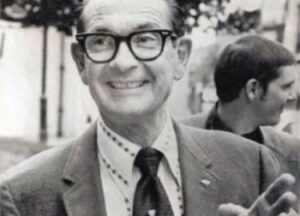J.D. Salinger (1919-2010) was drafted into the Army in 1942 and saw combat with the 12th Infantry Regiment,4th Infantry Division at Utah Beach on D-Day, in the Battle of the Bulge, and the Battle of Hürtgen Forest.
Medic has obtained the Official Military Personnel Records of Salinger. Unfortunately ,as was the case for thousands of veterans, most records pertaining to Salinger were destroyed in the July 12, 1973 fire at the National Personnel Records Center in St. Louis, MO. The remaining records are here. A brief account of the fire is here.
Medic has obtained additional records pertaining to Salinger’s military code and cypher training. Course outline. Course outlines, orders, schedules.
Because he spoke French and German,Salinger was assigned to a counter-intelligence unit to interrogate prisoners of war. In April 1945 he entered a liberated concentration camp and witnessed the horrors of the Nazi regime.
His experiences in the war affected him emotionally and he was hospitalized for combat stress after Germany was defeated. He later told his daughter: “You never really get the smell of burning flesh out of your nose entirely, no matter how long you live.”
Both of his biographers speculate that Salinger drew upon his wartime experiences in several stories, such as “For Esmé—with Love and Squalor,” which is narrated by a traumatized soldier.
_______
source: wikipedia
Sarah Morrill: A Brief Biography of J. D. Salinger
update: Salinger’s Unseen Writings to be Published, The Guardian, February, 2019
update: Salinger Exhibition at New York Public Library, The Guardian October, 2019
update: At the End of a Dirt Road, Thomas Powers, London Review of Books October, 2019

J.D. Salinger
J.D. Salinger (1919-2010) was drafted into the Army in 1942 and saw combat with the 12th Infantry Regiment,4th Infantry Division at Utah Beach on D-Day, in the Battle of the Bulge, and the Battle of Hürtgen Forest.
Medic has obtained the Official Military Personnel Records of Salinger. Unfortunately ,as was the case for thousands of veterans, most records pertaining to Salinger were destroyed in the July 12, 1973 fire at the National Personnel Records Center in St. Louis, MO. The remaining records are here. A brief account of the fire is here.
Medic has obtained additional records pertaining to Salinger’s military code and cypher training. Course outline. Course outlines, orders, schedules.
Because he spoke French and German,Salinger was assigned to a counter-intelligence unit to interrogate prisoners of war. In April 1945 he entered a liberated concentration camp and witnessed the horrors of the Nazi regime.
His experiences in the war affected him emotionally and he was hospitalized for combat stress after Germany was defeated. He later told his daughter: “You never really get the smell of burning flesh out of your nose entirely, no matter how long you live.”
Both of his biographers speculate that Salinger drew upon his wartime experiences in several stories, such as “For Esmé—with Love and Squalor,” which is narrated by a traumatized soldier.
_______
source: wikipedia
Sarah Morrill: A Brief Biography of J. D. Salinger
update: Salinger’s Unseen Writings to be Published, The Guardian, February, 2019
update: Salinger Exhibition at New York Public Library, The Guardian October, 2019
update: At the End of a Dirt Road, Thomas Powers, London Review of Books October, 2019